British Scones: A Tea Time Treat
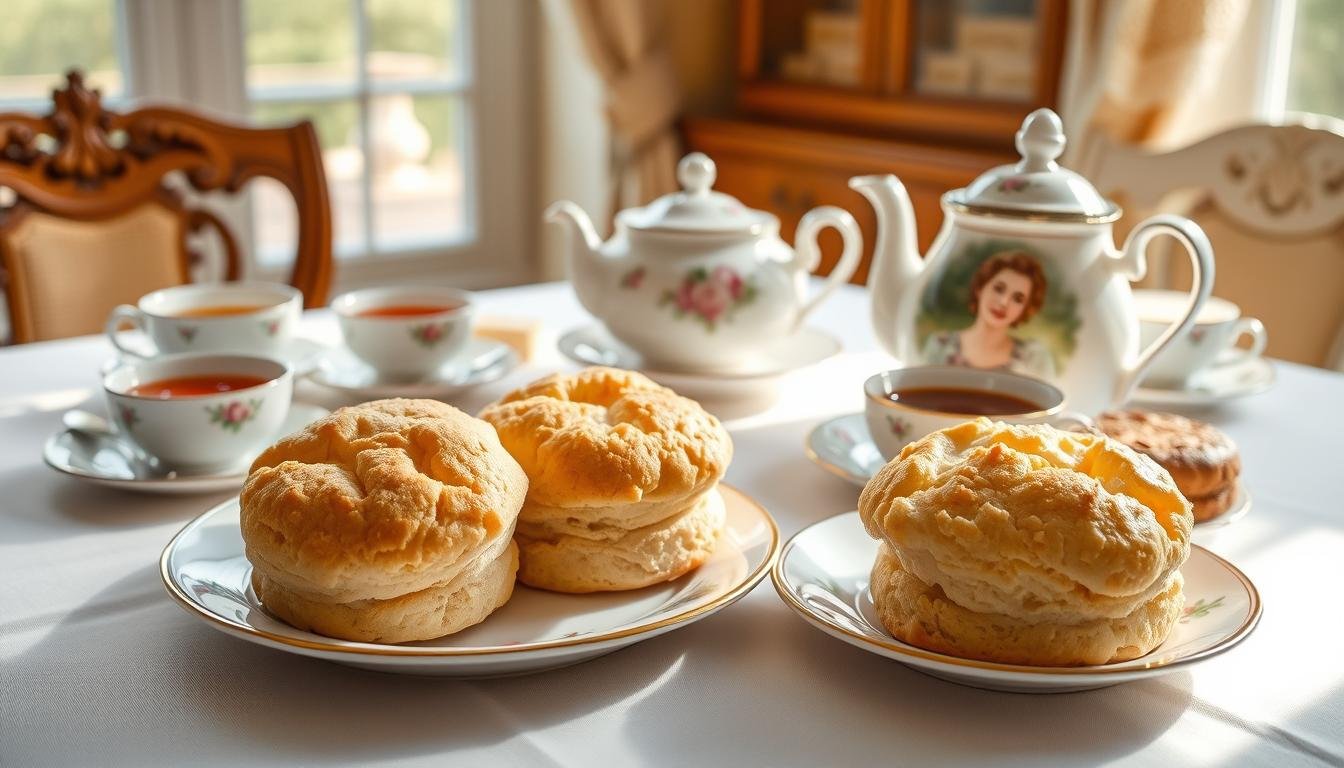
Ever wondered why British scones are key at afternoon tea? These tasty pastries are loved for their flaky texture and sweet taste. Let’s explore how to make these treats at home.
Scones are more than baked goods; they symbolize British cooking. Starting in Scotland, they’re now a big part of afternoon tea in the UK. Their golden outside and soft inside make them perfect with tea.
In this guide, you’ll learn to make real British scones. We’ll cover the key ingredients, methods, and tips. You’ll be able to make scones as good as those in fancy tea rooms.
Did you know Harrod’s in London used to sell scones for just 65p (about $1)? Though prices have gone up, scones are still loved. From Scotland to tea trays, scones have a special history and meaning.
Key Takeaways
- British scones started in Scotland and are now a big part of afternoon tea.
- A standard scone recipe uses about 8 ounces (226 grams) of flour.
- Scones are baked for 16 minutes at 400°F (205°C).
- Most people like to put jam on first when eating scones.
- The way to say “scone” varies in the UK, with some saying “skown” and others “scone”.
- Using quality ingredients, like homemade jams, makes scones even better.
- Scones can be frozen unbaked to keep them fresh.
Introduction to Traditional British Scones
Scones are a favorite in British culture, with deep roots in the nation’s food history. They started as simple Scottish oat cakes. Now, they’re a beloved treat enjoyed everywhere in the UK and beyond.
History and Cultural Significance
Scones have a long history in Britain, as tasty as they are. They’ve been a part of tea time since the 16th century. Their fame grew in the 1840s with Anna, the Duchess of Bedford’s, afternoon tea idea.
Today, scones are a big part of tea time. You can find many flavors, from plain to fruit and savory. They’re loved not just in the UK but also around the world, like American cream scones and Australian date scones.
| Scone Fact | Detail |
|---|---|
| Origin | Scotland (unleavened oat cake) |
| Popular Since | 16th century |
| Afternoon Tea Connection | Introduced by Duchess of Bedford, 1840s |
| Common Variations | Plain, fruit, savory |
| International Adaptations | American cream scones, Australian date scones |
Exploring British scones, you’ll find tradition meets innovation. They’re perfect for afternoon tea or brunch. These treats bring people together, showing the warmth and hospitality of British culture.
Essential Ingredients for Perfect Scones
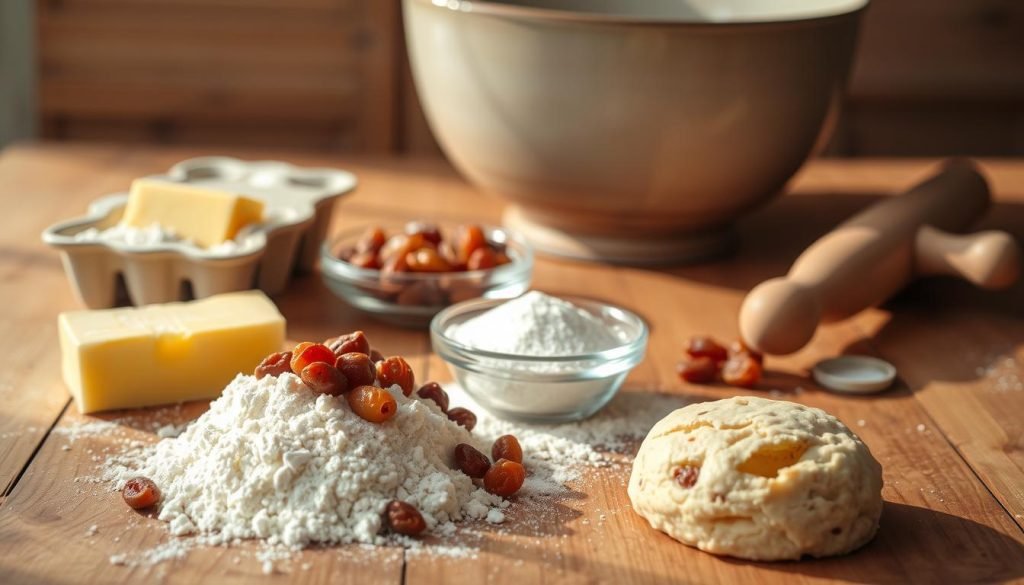
To make delicious scones, start with the right ingredients. This quick bread recipe is easy and rewarding. You’ll need 2 cups of all-purpose flour, 1 tablespoon of baking powder, and 1/2 teaspoon of salt for the dry mix.
For the wet ingredients, get 6 tablespoons of chilled unsalted butter and 2/3 cup of half-and-half.
Using very cold butter is key for fluffy scones. Cut it into small cubes and mix it into the flour until it looks like coarse crumbs. This step makes the scones tender.
For sweet scones, add 5 tablespoons of sugar. For savory scones, use 1-2 tablespoons of sugar. You can also add your favorite things like dried fruit, chocolate chips, or herbs.
| Ingredient | Amount | Purpose |
|---|---|---|
| All-purpose flour | 2 cups (250g) | Base structure |
| Baking powder | 2 teaspoons | Leavening agent |
| Unsalted butter | 1/2 cup (113g) | Flavor and texture |
| Heavy cream | 1/2 cup (120ml) | Moisture and richness |
With these ingredients, you can make 8 tasty scones. Easy recipes often give the best results. Gently knead the dough 5-10 times for the perfect texture. Your homemade scones will be as good as those from the finest British tea rooms!
British vs. American Scones: Key Differences
Scones are loved on both sides of the Atlantic. But British and American scones are quite different. Let’s look at what makes each special.
Texture and Consistency Variations
British scones are light and fluffy. American scones are denser and crumblier. British scones are round and plain, great for toppings. American scones are triangular and meant to be eaten alone.
Ingredient Variations
British scones have less sugar and butter, for a simpler taste. American scones have more fat and sugar, for a richer flavor. British scones might have dried fruits like raisins. American scones have mix-ins like blueberries or chocolate chips.
Serving Methods
The biggest difference is how they’re enjoyed. British scones are key to a Cream Tea, with Jam and Clotted Cream. Americans often eat scones alone, sometimes with a glaze.
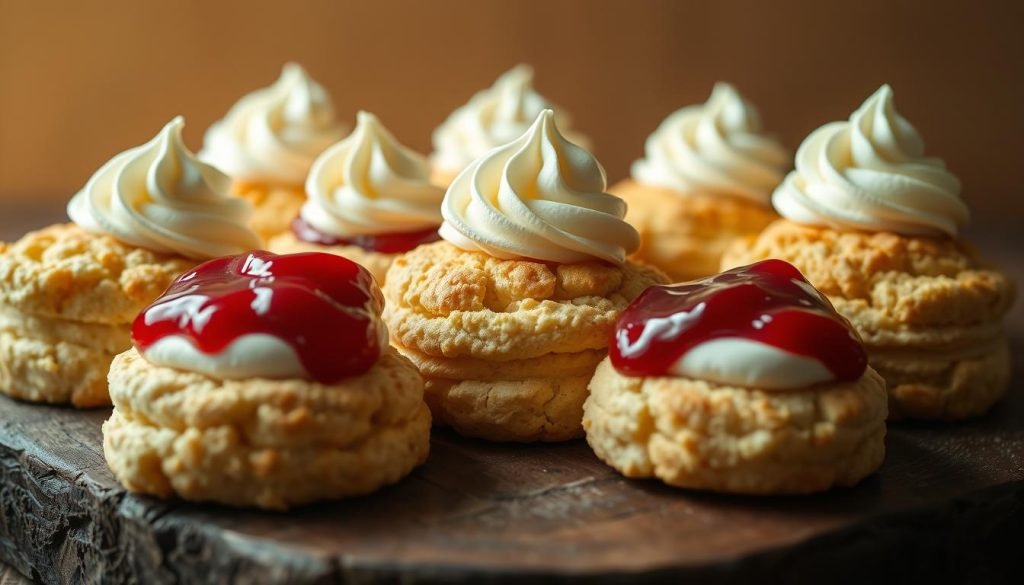
| Aspect | British Scones | American Scones |
|---|---|---|
| Shape | Round | Triangular or wedge-shaped |
| Texture | Light and fluffy | Dense and crumbly |
| Sweetness | Less sweet | Sweeter |
| Toppings | Clotted Cream and Jam | Often glazed or frosted |
| Flavors | Plain or with dried fruits | Various (e.g., blueberry, pumpkin) |
Step-by-Step Baking Instructions
Ready to make the best scones? Let’s dive into the easy process of creating these delightful treats. With just a few simple steps, you’ll be enjoying fresh, homemade scones in no time.
Preparing the Dough
To make scones, start by mixing 3 cups of flour, 1/3 cup of sugar, and 1 tablespoon of baking powder in a large bowl. Cut in 1 1/2 sticks of cold butter until the mixture resembles coarse crumbs. In a separate bowl, whisk together 1 cup of buttermilk and 2 eggs. Gently fold the wet ingredients into the dry mixture until just combined.
Shaping and Cutting
Turn the dough onto a lightly floured surface and pat it into a 1-inch thick rectangle. Fold the dough in thirds, like a letter, and repeat this process twice more. This technique creates layers for flaky scones. Pat the dough into a 1-inch thick circle and cut it into 8 wedges.

Baking Temperature and Timing
Preheat your oven to 400°F. Place the scones on a baking sheet, spacing them 2 inches apart. Bake for 16-18 minutes or until golden brown. The total time from start to finish is less than 40 minutes, making these easy scones perfect for a quick treat.
| Ingredient | Amount | Ratio to Flour |
|---|---|---|
| All-purpose flour | 3 cups (381g) | 1:1 |
| Granulated sugar | 1/3 cup (66g) | 1:11.5 |
| Baking powder | 1 tablespoon | 1:3 |
| Unsalted butter | 1 1/2 sticks (170g) | 1:2.24 |
| Buttermilk | 1 cup (237g) | 1:3.81 |
Tips for Light and Fluffy Scones
Learning to make light and fluffy scones is crucial. UK bakers use these tips to get it right. Start by using cold butter, cut into small cubes. This creates flaky layers in your scones.
When mixing, be gentle. Overworking makes scones tough. Mix just until everything comes together. Remember, lumps are good in scone making!
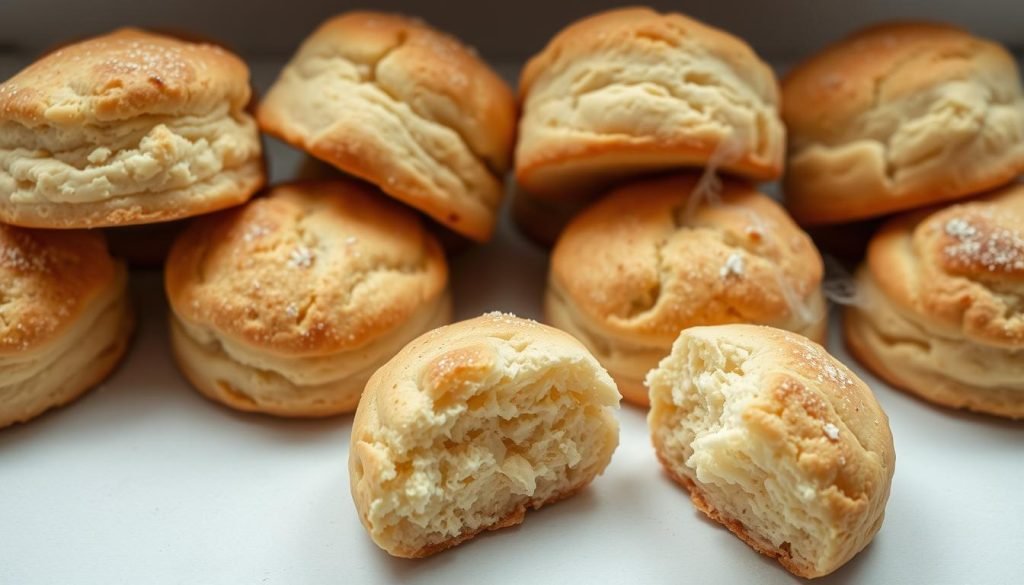
Preheat your oven to 425°F (220°C) before starting. A hot oven is key for a perfect rise. Roll your dough to about 1 inch thick and use a 2.5-inch cutter for uniform scones. Let your scones rest on the baking tray for a few minutes before glazing.
Here’s a quick guide to help you achieve scone perfection:
| Ingredient | Amount | Tips |
|---|---|---|
| Strong white flour | 3 1/2 cups (500g) | Weigh for accuracy |
| Baking powder | 4-5 teaspoons | Use fresh, opened less than 6 months ago |
| Unsalted butter | 6 tablespoons | Keep cold until use |
| Sugar | 1/4 cup | Adjust to taste |
| Whole milk | 2/3 cup | Cold from the fridge |
Bake your scones for about 15 minutes until golden brown. With these tips, your scone recipes will yield approximately 10 servings of light, fluffy, and irresistible scones.
Traditional Accompaniments
No British tea party is complete without the perfect accompaniments for your scones. Let’s explore the classic pairings that turn these sweet treats into a delightful dessert experience.
Clotted Cream Guide
Clotted cream is the crown jewel of scone toppings. This rich, velvety cream boasts an impressive 56% butterfat content. It’s traditionally made by heating unpasteurized cow’s milk, resulting in a thick, luxurious spread that’s essential for an authentic British tea time.
Jam Selection
Complement your scones with a dollop of fruity jam. Strawberry and raspberry are popular choices, but don’t be afraid to experiment. The sweetness of the jam balances perfectly with the cream and scone, creating a harmonious flavor profile.
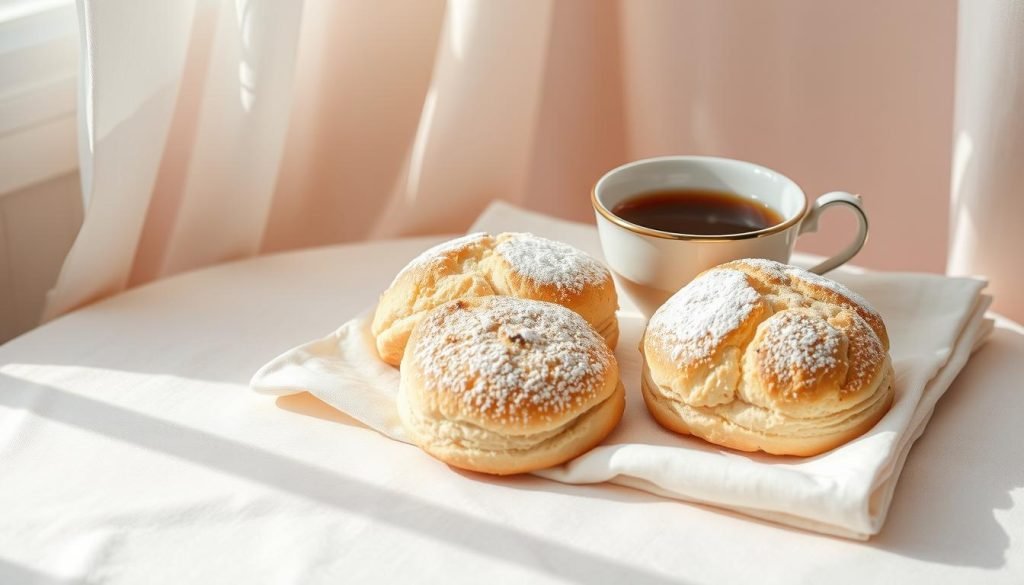
Proper Tea Pairing
Choose your tea wisely to enhance your scone experience. A robust English Breakfast tea pairs well with traditional scones, while Earl Grey offers a delicate flavor that complements fruit-filled varieties. For a truly indulgent treat, try a fragrant Darjeeling.
| Accompaniment | Description | Pairing Suggestion |
|---|---|---|
| Clotted Cream | Rich, thick cream (56% butterfat) | Spread generously on scones |
| Strawberry Jam | Sweet, fruity preserve | Layer on top of clotted cream |
| English Breakfast Tea | Full-bodied black tea | Pairs well with plain scones |
Remember, the order of cream and jam can spark friendly debates. In Devon, it’s cream first, while Cornwall prefers jam first. Whichever way you choose, these accompaniments will elevate your scones from simple baked goods to the star of your tea party spread.
Serving and Presentation Guidelines
Make your tea time special with these serving tips for British scones. Afternoon tea recipes look great when presented well. This makes the treats even more enjoyable.
Serve warm scones in a cloth-lined basket for a classic look. This keeps the scones warm and inviting. For a fancy touch, use a tiered stand to display your scones with other treats.
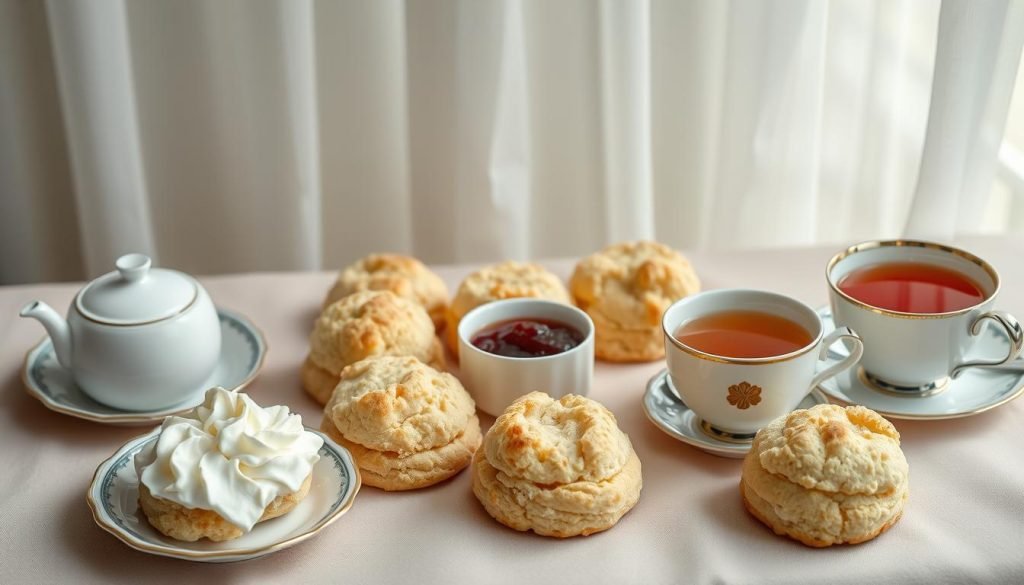
Be careful with how you arrange your scones. Put them on the middle tier of your stand. Place clotted cream and jam on the bottom tier for easy access. This makes it easy for guests to make their scones without reaching.
| Item | Placement | Quantity |
|---|---|---|
| Scones | Middle tier | 6-8 servings |
| Clotted cream | Bottom tier | 1 small bowl |
| Jam varieties | Bottom tier | 2-3 small bowls |
| Tea pot | Side table | 1 per 2-3 guests |
Don’t forget to give your guests small plates and napkins. Offer different jams like strawberry, apricot, or peach. Serve your scones with Earl Grey tea for a true British tea time.
Storage and Freezing Methods
Learning how to store and freeze scones is crucial. It lets you enjoy these treats for longer. With the right methods, you can have fresh-tasting scones for days or even months.
Fresh Storage Tips
Scones are best when they’re fresh. But you can keep them at room temperature for a few days. Let them cool completely after baking.
Wrap them tightly in plastic wrap or store in an airtight container. This way, scones stay fresh for up to three days.
Freezing Instructions
Freezing makes scones last longer. You can freeze both baked and unbaked scones:
- Baked scones: Wrap each one in plastic wrap, then put them in a freezer bag. They’ll last 2-3 months.
- Unbaked dough: Shape the scones, freeze them on a baking sheet for 1-2 hours. Then, move them to a freezer bag.

Reheating Guidelines
To enjoy frozen scones:
- Thaw them at room temperature for an hour.
- Preheat your oven to 350°F.
- Warm the scones for 5-7 minutes.
For unbaked frozen scones, bake them straight from the freezer. Add 5-10 minutes to the baking time. These tips and tricks make sure you always have tasty scones for your next tea time or breakfast.
Common Baking Mistakes to Avoid
Learning to make scones can have its challenges. Let’s look at some common mistakes to help you make perfect scones every time.
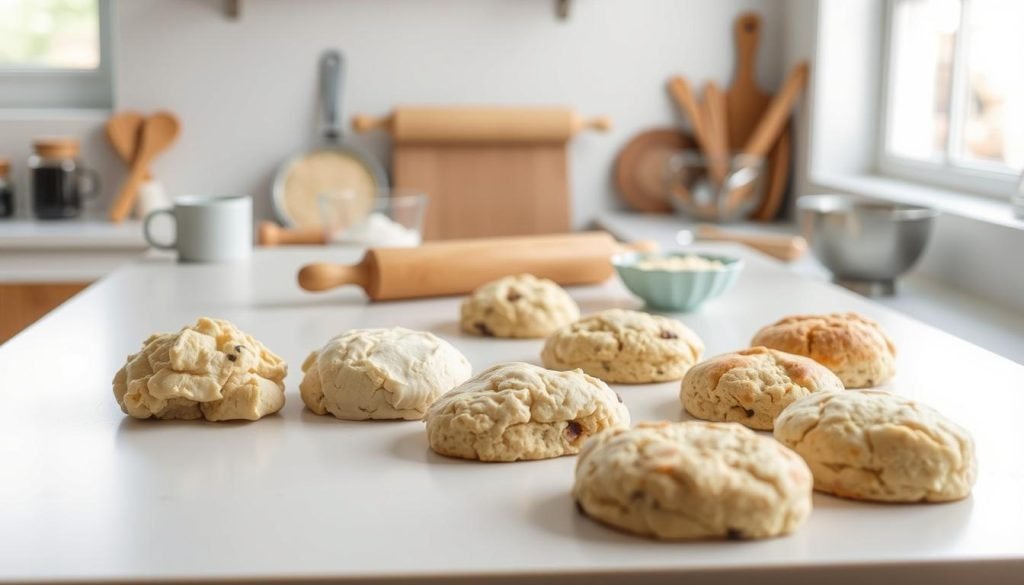
One big mistake is overworking the dough. Too much mixing makes the scones tough, like bread. It’s important to handle the dough gently.
Another mistake is using room-temperature ingredients. For flaky scones, start with cold butter, eggs, and cream. This is key for the right texture.
Not chilling the dough is also a mistake. After shaping, put the dough in the fridge. This keeps it consistent before baking.
| Mistake | Effect | Solution |
|---|---|---|
| Overworking dough | Tough, chewy scones | Mix ingredients just until combined |
| Warm ingredients | Lack of flakiness | Use cold butter, eggs, and cream |
| Skipping chilling | Poor texture | Chill shaped dough before baking |
| Inaccurate measurements | Improper rise | Measure leavening agents precisely |
Avoiding these mistakes will help you make the best scones. Remember, practice makes perfect. Don’t worry if your first batch isn’t perfect!
Variations and Add-ins
Scone recipes can be made in many ways. You can make tasty treats for any event. Let’s look at some fun ways to make your baking better.
Fruit Additions
Fruit scones are loved by those who like sweet things. You can add up to 1 cup of fresh or dried fruit. Try blueberries, cranberries, or cherries for extra flavor.
For a tropical taste, add ¾ cup of shredded coconut and 1 tablespoon of lime zest.
Savory Options
Savory scones are great with soups or salads. Cut the sugar to 2 tablespoons and add 1 cup of shredded cheese. For a Cacio e Pepe flavor, use 1½ cups of grated pecorino and 2 tablespoons of black pepper.
Another good choice is Cheddar, Basil, and Sun-Dried Tomato scones. They mix 1 cup cheddar, ¼ cup fresh basil, and ½ cup sun-dried tomatoes.

Seasonal Adaptations
Make your scones fit the season for a special treat. In fall, try Pumpkin or Caramel Apple scones. For spring, Lemon Blueberry scones are perfect.
Mix in 2 cups of blueberries and 1 tablespoon of lemon zest. You can freeze shaped scones for up to a month. This is great for making seasonal treats ahead of time.
These easy recipes let you try different flavors while keeping the scone texture. Whether you like sweet or savory, there’s a scone for everyone.
Conclusion
You’ve started a fun journey into British food and baking. Scones are a big part of British cooking. They can be sweet or savory, made with just a few simple ingredients.
For the best scones, mix texture and taste right. Bake them at 400°F for 25-35 minutes. Adjust the sugar to 1/3 to 1/2 cup to your liking. Use 1 tablespoon of baking powder and 3/4 teaspoon of baking soda for the perfect rise.
Try adding Craisins or fresh fruits to your scones. They’re great for afternoon tea or a cozy snack. With these recipes, you can make your kitchen feel like a British bakery.